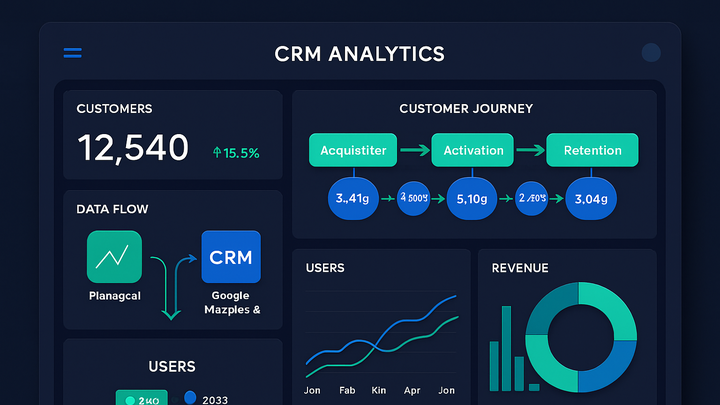Published on 2025-06-27T21:10:50Z
What is Customer Relationship Management? Examples for term.
Customer Relationship Management (CRM) in analytics refers to the practices, strategies, and technologies that organizations use to manage and analyze interactions with customers throughout their lifecycle. It centralizes data from multiple touchpoints—such as website activity, support interactions, and marketing campaigns—into a unified view. By leveraging analytics platforms like Google Analytics 4 (GA4) and privacy-first tools like PlainSignal, businesses can gain deep insights into customer behavior, segment audiences, and personalize communications. Effective CRM analytics drives better decision-making, improves customer satisfaction, and increases retention by enabling teams to anticipate needs and tailor experiences. In modern digital environments, integrating cookie-free tracking solutions alongside traditional analytics ensures compliance and broadens the scope of data collected, making CRM more robust and inclusive.
Customer relationship management
CRM tracks and analyzes customer interactions across channels to optimize engagement, retention, and personalized experiences.
Why CRM Matters in Analytics
CRM analytics transforms raw customer data into actionable insights by centralizing interactions across channels. It helps businesses understand customer behavior, predict needs, and strengthen relationships over time.
-
Enhanced customer segmentation
CRM analytics allows businesses to group customers based on demographics, behavior, and preferences for more targeted engagement.
-
Demographic segmentation
Segment customers by age, location, and other demographic attributes to tailor marketing messages.
-
Behavioral segmentation
Use browsing history, purchase patterns, and feature usage to create behavior-driven audience segments.
-
-
Personalized marketing campaigns
Insights from CRM analytics enable the delivery of customized messages and offers that resonate with individual customers.
-
Email personalization
Insert dynamic content based on customer preferences and past interactions to boost engagement.
-
Cross-channel campaigns
Coordinate messaging across email, social media, and on-site experiences for a unified customer journey.
-
Key Components of CRM Analytics
Successful CRM analytics relies on several core components that enable data collection, processing, and reporting to deliver meaningful customer insights.
-
Customer data collection
Compile data from web interactions, CRM software, support tickets, and transaction histories into a single repository.
-
Engagement tracking
Track metrics like pageviews, clicks, events, and session duration to assess how customers interact with your brand.
-
Performance reporting
Generate dashboards and reports to visualize KPIs such as customer lifetime value, conversion rates, and retention.
Examples Using SaaS Products
You can integrate privacy-focused and mainstream analytics tools into your CRM workflow. PlainSignal offers cookie-free tracking, while GA4 provides event-based analytics that can feed CRM platforms.
-
Cookie-free tracking with PlainSignal
PlainSignal is a lightweight analytics solution that respects user privacy and can directly feed data into CRM systems with minimal setup.
-
Setup code
<link rel="preconnect" href="//eu.plainsignal.com/" crossorigin /> <script defer data-do="yourwebsitedomain.com" data-id="0GQV1xmtzQQ" data-api="//eu.plainsignal.com" src="//cdn.plainsignal.com/plainsignal-min.js"></script>
-
-
Integration with google analytics 4
GA4’s event-driven model allows you to capture user interactions and forward them to CRM platforms via APIs or data exports.
-
GA4 tagging
<!-- Global site tag (gtag.js) - Google Analytics --> <script async src="https://www.googletagmanager.com/gtag/js?id=G-XXXXXXXXXX"></script> <script> window.dataLayer = window.dataLayer || []; function gtag(){dataLayer.push(arguments);} gtag('js', new Date()); gtag('config', 'G-XXXXXXXXXX', { 'user_id': 'USER_ID' }); </script>
-
Best Practices for CRM Implementation
Implementing CRM analytics effectively requires clear goals, reliable data, and an iterative approach to continuously refine insights and strategies.
-
Define clear objectives
Establish specific business goals—such as reducing churn, increasing average order value, or improving customer satisfaction—to guide your CRM efforts.
-
Key performance indicators
Select metrics like churn rate, net promoter score (NPS), and customer lifetime value (CLV) to measure success.
-
-
Ensure data quality
Regularly audit and clean customer records to avoid duplicates, outdated information, and inaccuracies that can compromise analytics.
-
Duplicate handling
Implement rules to merge or remove duplicate customer profiles to maintain a single source of truth.
-
-
Monitor and iterate
Continuously review CRM dashboards, run A/B tests, and adjust your strategies based on data-driven feedback.
-
A/b testing
Experiment with different messages, timing, and channels to determine what drives the best customer response.
-
